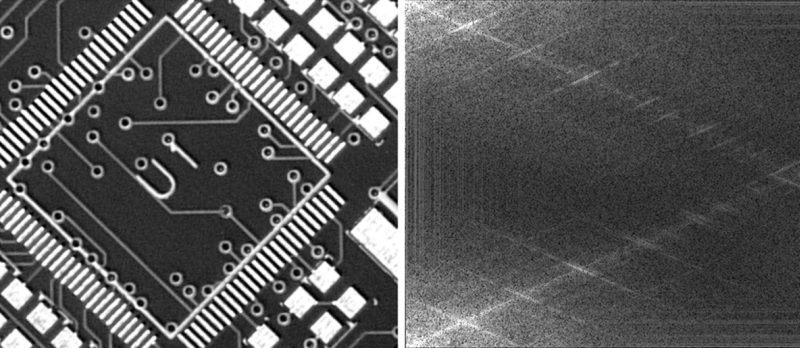Basics
| ● | The Fourier transform consists in representing an image by its frequential components. You can then process the frequential components image (also called the Fourier image) to perform specific filtering. |

Left: the image of a PCB, oriented at 45°
Right: the corresponding Fourier Image (scaled for visualization)
with the frequential structures that are scaled as well
| ● | The Fourier images contain complex numbers and are represented by a floating point image (EFourierImage). |
| ● | In Open eVision, use an object In a general content, the term object should be understood with the meaning of a class instance. In EasyObject, an object is a maximally-sized area of adjacent connected pixels belonging to the layer foreground. EFourierTransformer to perform the conversion between spatial and Fourier images. |
| □ | Use the method DirectTransform to convert a spatial image EImageBW8, EImageBW16 or EImageBW32f to an image EFourierImage. |
| □ | Use the method InverseTransform to convert images the other way around. |
| ● | When converting to a Fourier image and back to a spatial image, this scaling factor must be applied to preserve the initial scale: 1 / (height × width). |
How to split the scaling between direct and inverse transform depends on the library implementation. In Open eVision:
| □ | The method DirectTransform does not apply any scale factor. |
| □ | The method InverseTransform applies a scale factor of 1 / (height × width). |
| ● | The EFourierImage shares the same methods as the EImageBW32f. |
| ● | An EFourierImage may contain high values due to the nature of the applied transformation and this may be difficult to display on a screen. For an easier visualization, use ComputeMagnitude(EImageBW8&) and ComputePhase(EImageBW8&) to generate an image that can be drawn or saved. |
Frequential format
As the Fourier images contain redundant data, there are different possible representations.
| □ | Open eVision supports the Packed and Complex Extended formats. |
| □ | Use the method FrequentialDomainFormat on a EFourierImage to select a format. This format is used when calling the methods of EFourierTransformer. |
Calling this method does not trigger a conversion.
The Complex Extended format
The Complex Extended is the simplest of these two formats.
| ● | The only subtlety is that the complex numbers are stored in a floating point array, so the complex extended image is twice larger than the spatial image. |
| ● | Each odd column contains the imaginary part of a complex number. |
| ● | The following table is an illustration of an image in Complex Extended format, where the complex pixel at row i and column j is: |
Re(i,j) + i × Im(i,j)
| Re(0,0) | Im(0,0) | … | Im(0,w-1) |
| Re(1,0) | Im(1,0) | … | Im(1,w-1) |
| … | … | … | … |
| Re(h-1,0) | Im(h-1,0) | … | Im(h-1,w-1) |
A Fourier image in the Complex Extended format
The Packed format
The Packed format is also called Complex Conjugate Symmetrical.
| ● | It takes benefit of the conjugate symmetric properties of the Fourier transform of a real image to reduce the Fourier image size and to be the same as the spatial image size. |
| ● | The following table is an illustration of an image in Packed format, where the complex pixel at row i and column j is: |
Re(i,j) + i × Im(i,j)
There is a difference between images of odd and even height:
|
Re(0,0) |
Re(0,1) |
Im(0,1) |
… |
Re(0,(w-1)/2) |
Im(0,(w-1)/2) |
Re(0,w/2) |
|
Re(1,0) |
Re(1,1) |
Im(1,1) |
… |
Re(1,(w-1)/2) |
Im(1,(w-1)/2) |
Re(1,w/2) |
|
Im(1,0) |
Re(2,1) |
Im(2,1) |
… |
Re(2,(w-1)/2) |
Im(2,(w-1)/2) |
Im(1,w/2) |
|
… |
… |
… |
… |
… |
… |
… |
|
Re(h/2,0) |
Re(h-2,1) |
Im(h-2,1) |
… |
Re(h-2,(w-1)/2) |
Im(h-2,(w-1)/2) |
Re(h/2,w/2) |
|
Im(h/2,0) |
Re(h-1,1) |
Im(h-1,1) |
… |
Re(h-1,(w-1))/2 |
Im(h-1,(w-1)/2) |
Im(h/2,w/2) |
A Fourier image in packed format, odd height
|
Re(0,0) |
Re(0,1) |
Im(0,1) |
… |
Re(0,(w-1)/2) |
Im(0,(w-1)/2) |
Re(0,w/2) |
|
Re(1,0) |
Re(1,1) |
Im(1,1) |
… |
Re(1,(w-1)/2) |
Im(1,(w-1)/2) |
Re(1,w/2) |
|
Im(1,0) |
Re(2,1) |
Im(2,1) |
… |
Re(2,(w-1)/2) |
Im(2,(w-1)/2) |
Im(1,w/2) |
|
… |
… |
… |
… |
… |
… |
… |
|
Re(h/2-1,0) |
Re(h-3,1) |
Im(h-3,1) |
… |
Re(h-3,(w-1)/2) |
Im(h-3,(w-1)/2) |
Re(h/2-1,w/2) |
|
Im(h/2-1,0) |
Re(h-2,1) |
Im(h-2,1) |
… |
Re(h-2,(w-1)/2) |
Im(h-2,(w-1)/2) |
Im(h/2-1,w/2) |
|
Re(h/2,0) |
Re(h-1,1) |
Im(h-1,1) |
… |
Re(h-1,(w-1)/2) |
Im(h-1,(w-1)/2) |
Re(h/2,w/2) |
A Fourier image in packed format, even height
| ● | The other coefficients are obtained by using the following properties: |
|
Re(i,j) = Re(h-i,w-j) | and | Im(i,j) = -Im(h-i,w-j) | |||
|
Re(0,j) = Re(0,w-j) | and | Im(0,j) = -Im(0,w-j) | |||
|
Re(i,0) = Re(h-i,0) | and | Im(i,0) = -Im(h-i,0) |